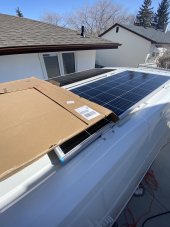Hello all,
I’ve installed two 200 Watt (corrected, had as amps ? ) Renogy panels in parallel on a Van. These are tied in to a Renogy DC-DC MPPT charge controller.
) Renogy panels in parallel on a Van. These are tied in to a Renogy DC-DC MPPT charge controller.
Panel voltage should be 22V optimum for both and 27V open circuit.
I am getting 26.1V to the charge controller, from either panel. Confirmed similar voltage at each panel.
It is very sunny but also cold, about 5 Celsius.
By covering both panels about 10%, I was able to get the voltage down to 23V so the PV high alarm on the controller turned off and it would start charging the battery. Threshold for max PV is right around 25V.
Any ideas on what may be causing this issue and thoughts on how to correct it?
I’ve installed two 200 Watt (corrected, had as amps ?
Panel voltage should be 22V optimum for both and 27V open circuit.
I am getting 26.1V to the charge controller, from either panel. Confirmed similar voltage at each panel.
It is very sunny but also cold, about 5 Celsius.
By covering both panels about 10%, I was able to get the voltage down to 23V so the PV high alarm on the controller turned off and it would start charging the battery. Threshold for max PV is right around 25V.
Any ideas on what may be causing this issue and thoughts on how to correct it?
Attachments
Last edited:







